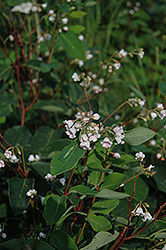It's all about ...
plants

Spreading Dogbane
Apocynum androsaemifolium
Height: 24 inches
Spread: 3 feet
Sunlight:
![]()
![]()
![]()
Hardiness Zone: 4a
Other Names: Fly-Trap Dogbane
Description:
A widely branching, bushy perennial with opposite oval leaves that have lighter green veins and gray green reverses; clusters of tiny white and pink bell shaped flowers appear in summer at the branch tips; an adaptable, attractive groundcover
Ornamental Features
Spreading Dogbane features showy clusters of white bell-shaped flowers with pink stripes at the ends of the stems in early summer, which emerge from distinctive pink flower buds. Its attractive oval leaves remain dark green in colour with curious grayish green undersides throughout the season. The brick red stems can be quite attractive.
Landscape Attributes
Spreading Dogbane is an herbaceous perennial with an upright spreading habit of growth. Its medium texture blends into the garden, but can always be balanced by a couple of finer or coarser plants for an effective composition.
This is a relatively low maintenance plant, and should be cut back in late fall in preparation for winter. It is a good choice for attracting bees and butterflies to your yard, but is not particularly attractive to deer who tend to leave it alone in favor of tastier treats. It has no significant negative characteristics.
Spreading Dogbane is recommended for the following landscape applications;
- Mass Planting
- Rock/Alpine Gardens
- General Garden Use
Planting & Growing
Spreading Dogbane will grow to be about 24 inches tall at maturity, with a spread of 3 feet. It grows at a fast rate, and under ideal conditions can be expected to live for approximately 10 years. As an herbaceous perennial, this plant will usually die back to the crown each winter, and will regrow from the base each spring. Be careful not to disturb the crown in late winter when it may not be readily seen!
This plant performs well in both full sun and full shade. It is very adaptable to both dry and moist locations, and should do just fine under typical garden conditions. It is not particular as to soil type or pH. It is highly tolerant of urban pollution and will even thrive in inner city environments. This species is native to parts of North America, and parts of it are known to be toxic to humans and animals, so care should be exercised in planting it around children and pets.
This plant is not reliably hardy in our region, and certain restrictions may apply; contact the store for more information.
